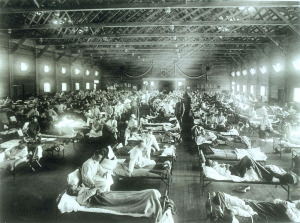
The flu pandemic of 1918 was one of the largest and deadliest in history. The influenza, or flu, pandemic infected about 500 million people—about one third of the planet’s population at that time. The flu infected more than 25 percent of the U.S. population, and more than 675,000 Americans died. The disease was first seen in Europe, the U.S., and parts of Asia. Then it spread around the world. The first flu vaccine was decades away; there was no effective treatment available in 1918.
The first wave of influenza infections happened in the spring of 1918. The deadly outbreak grew into a pandemic by the fall of that year. The disease was called Spanish Influenza because most of the early deaths occurred in Spain. The Spanish king Alfonso XIII contracted the flu, but did not die from it. U.S. president Woodrow Wilson also contracted the flu while in France negotiating the Treaty of Versailles to end World War I.
According to journalist Gina Kolata from
The New York Times
, 40 percent of the U.S. Navy and 36 percent of the U.S. Army contracted the flu. More World War I soldiers died from the flu than in battle. Surprisingly, many of those who died were healthy adults or young kids, people with otherwise strong immune systems.
The deadly flu became so widespread that hospitals overflowed. Schools, homes and other buildings were converted into makeshift hospitals run by medical students. Some city officials created rules to limit the spread of the flu. People had to wear masks outside of their homes and could not spit on the ground. If someone spit on the ground, a Boy Scout would give them a red card saying, “You are in violation of the Sanitary Code.”
Many people had to dig their family members’ graves because funeral parlors were full. Mail delivery, garbage, and other services shut down as many workers became sick. Farmers could not harvest their crops for lack of workers.
Years later, researchers discovered why the flu was so deadly: the virus caused pneumonia in the lungs of the infected. The researchers found three genes that enabled the virus to weaken the victim’s bronchial tubes, leading to bacterial pneumonia.
The most recent flu pandemic, referred to as the Swine flu, only killed about 12,000 people. By comparison approximately 20 to 50 million people died from the 1918 flu pandemic. It was truly the deadliest pandemic in modern history.
[Sources:
History.com
;
National Geographic
]

